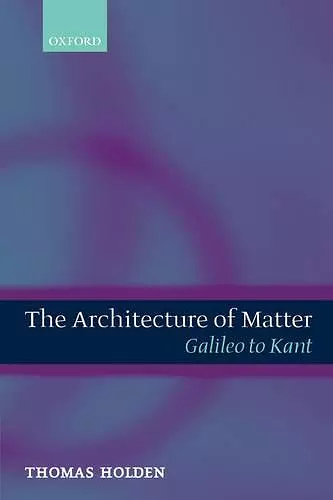The Architecture of Matter
Galileo to Kant
Format:Paperback
Publisher:Oxford University Press
Published:14th Dec '06
Currently unavailable, and unfortunately no date known when it will be back
This paperback is available in another edition too:
- Hardback£127.50was £127.50(9780199263264)

Thomas Holden presents a fascinating study of theories of matter in the seventeenth and eighteenth centuries. These theories were plagued by a complex of interrelated problems concerning matter's divisibility, composition, and internal architecture. Is any material body infinitely divisible? Must we posit atoms or elemental minima from which bodies are ultimately composed? Are the parts of material bodies themselves material concreta? Or are they merely potentialities or possible existents? Questions such as these - and the press of subtler questions hidden in their amibiguities - deeply unsettled philosophers of the early modern period. They seemed to expose serious paradoxes in the new world view pioneered by Galileo, Descartes, and Newton. The new science's account of a fundamentally geometrical Creation, mathematicizable and intelligible to the human inquirer, seemed to be under threat. This was a great scandal, and the philosophers of the period accordingly made various attempts to disarm the paradoxes. All the great figures address the issue: most famously Leibniz and Kant, but also Galileo, Hobbes, Newton, Hume, and Reid, in addition to a crowd of lesser figures. Thomas Holden offers a brilliant synthesis of these discussions and presents his own overarching interpretation of the controversy, locating the underlying problem in the tension between the early moderns' account of material parts on the one hand and the programme of the geometrization of nature on the other.
Review from previous edition Holden has made an important contribution. His aim of locating every major natural philosopher of the period within the gridwork of an original classificatory system is fully realized. The book is an unqualified success in showing how Kant's problems in the late eighteenth century are continuous with Galileo's problems in the early seventeenth. * Catherine Wilson, British Journal for the History of Philosophy *
a very well researched, clearly written, and thought-provoking examination of what the internal structure of physically extended bodies was thought to be by Western scientists and philosophers in the seventeenth and eighteenth centuries * Notre Dame Philosophical Reviews *
ISBN: 9780199204205
Dimensions: 233mm x 156mm x 18mm
Weight: 447g
320 pages